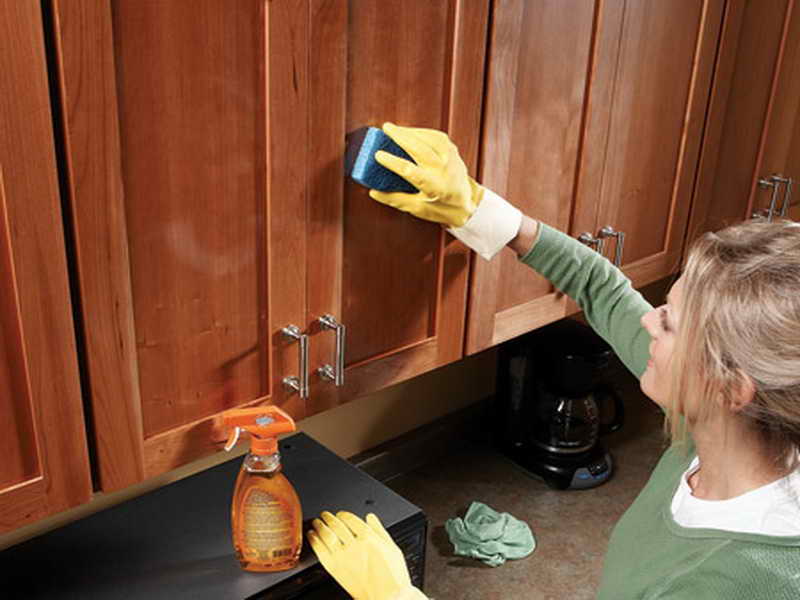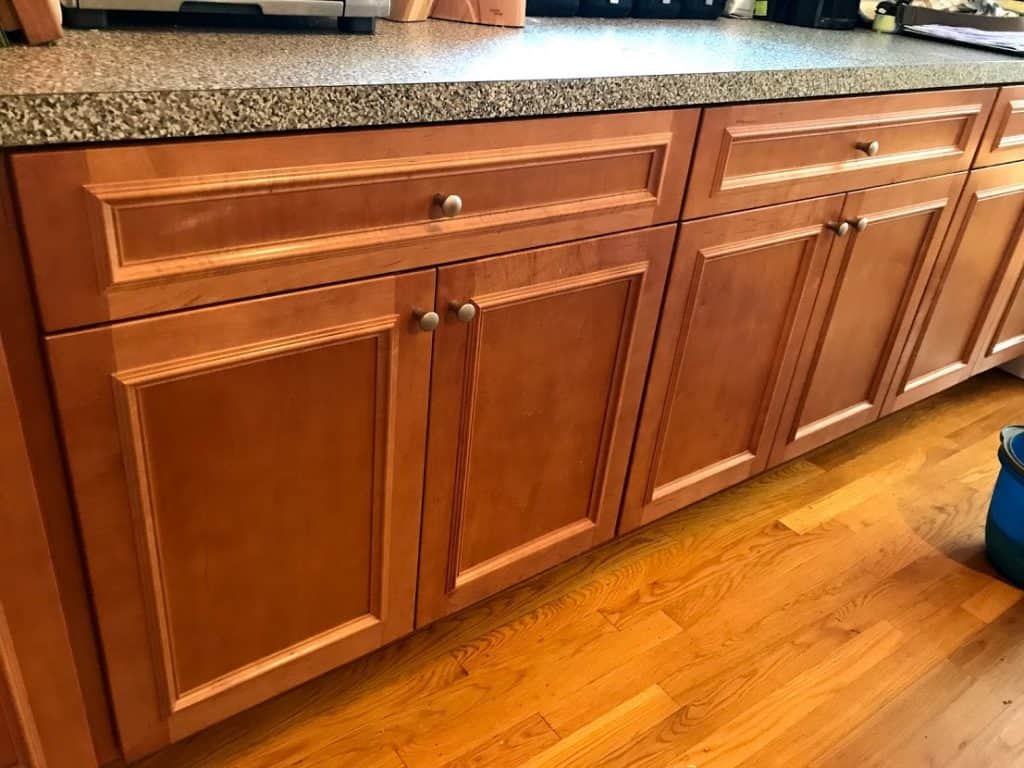Preparing Your Unfinished Cabinets

Before embarking on the journey of cleaning your unfinished wood cabinets, a crucial step often overlooked is sanding. Sanding is not merely an aesthetic enhancement but a fundamental preparation that sets the stage for a successful cleaning process.
Sanding Unfinished Wood Cabinets
Sanding unfinished wood cabinets is essential for removing surface imperfections, smoothing the wood, and creating a uniform surface for cleaning. The sanding process also helps to open up the wood pores, allowing cleaning agents to penetrate more effectively.
- Choosing the Right Sandpaper: The choice of sandpaper grit is paramount. Begin with a coarse grit sandpaper, such as 80-grit, to remove any significant imperfections or rough spots. Progress to a medium grit sandpaper, such as 120-grit, for a smoother finish. Finally, use a fine grit sandpaper, such as 220-grit, for a polished and refined surface.
- Sanding Technique: Always sand with the grain of the wood. This means following the direction of the wood fibers, which you can identify by looking at the wood’s natural pattern. Sanding against the grain can create scratches and damage the wood’s surface. Apply gentle pressure while sanding, avoiding excessive force that could cause gouges or unevenness.
- Sanding in Sections: Divide the cabinet surfaces into manageable sections. Sand each section thoroughly, ensuring consistent coverage.
- Dust Removal: After each sanding stage, it’s crucial to remove dust particles thoroughly. This prevents dust from embedding into the wood pores, making cleaning less effective.
Dust Removal
Dust removal after sanding is a critical step in preparing unfinished wood cabinets for cleaning. Dust particles, if left unchecked, can hinder the effectiveness of cleaning agents and compromise the final appearance.
- Vacuuming: Use a vacuum cleaner with a brush attachment to remove loose dust particles. Ensure the vacuum cleaner has a HEPA filter to capture fine dust particles effectively.
- Tack Cloth: After vacuuming, use a tack cloth to pick up any remaining dust particles. Tack cloths are made of a sticky material that traps dust, leaving a clean surface.
- Damp Cloth: Lightly dampen a clean cloth with water and wipe down the sanded surfaces to remove any lingering dust particles.
Protecting Surrounding Areas
Sanding unfinished wood cabinets generates dust, which can settle on surrounding surfaces and create a mess. To protect these areas, consider the following:
- Drop Cloths: Cover surrounding areas with drop cloths or plastic sheeting to prevent dust from settling.
- Tape: Use masking tape to protect areas that cannot be covered, such as door frames or trim.
- Ventilation: Open windows or use a fan to improve ventilation and minimize dust accumulation in the room.
Cleaning Unfinished Wood Cabinets

Cleaning unfinished wood cabinets requires a gentle approach to preserve their natural beauty and prevent damage. The porous nature of unfinished wood makes it susceptible to stains and scratches, so using the right cleaning methods is crucial.
Cleaning Methods for Unfinished Wood Cabinets
The choice of cleaning method depends on the type of dirt or stain you’re dealing with. Here are some common methods:
- Damp Cloth: For light dust or debris, a damp cloth is sufficient. Wring out excess water to avoid soaking the wood.
- Wood Cleaner: For deeper cleaning or to remove stubborn stains, a wood cleaner specifically designed for unfinished wood is recommended. Follow the instructions on the product label.
- Mild Soap Solution: A mild soap solution can be used for general cleaning. Mix a few drops of dish soap with warm water. Avoid using harsh detergents or abrasive cleaners, as they can damage the wood.
Importance of Using a Soft Cloth, How to clean unfinished wood kitchen cabinets
Using a soft cloth is essential for preventing scratches on the delicate surface of unfinished wood. A microfiber cloth or a soft cotton cloth is ideal. Avoid using abrasive materials like sponges, steel wool, or scouring pads.
Cleaning Techniques for Removing Stains, Grease, or Spills
For stains, grease, or spills, prompt action is crucial.
- Stains: Blot the stain with a clean, damp cloth. Avoid rubbing, as this can spread the stain. For stubborn stains, try a mild wood cleaner or a paste made from baking soda and water.
- Grease: Apply a small amount of dish soap to a damp cloth and gently rub the greasy area. Rinse the area with clean water and dry thoroughly.
- Spills: Wipe up spills immediately with a clean, damp cloth. Avoid letting liquids sit on the wood for extended periods, as this can lead to staining or warping.
Drying Unfinished Wood Cabinets Properly
After cleaning, it’s essential to dry the cabinets thoroughly to prevent moisture damage.
- Air Drying: Allow the cabinets to air dry naturally. Avoid using a hairdryer or other heat sources, as this can cause the wood to warp or crack.
- Soft Cloth: Gently wipe the cabinets with a dry, soft cloth to remove any remaining moisture.
Finishing Touches for Unfinished Wood Cabinets: How To Clean Unfinished Wood Kitchen Cabinets

The final step in transforming your unfinished wood cabinets is applying a sealant or finish. This step not only enhances the appearance but also provides crucial protection against wear and tear, moisture, and stains, ensuring the longevity and beauty of your cabinets.
Types of Wood Finishes
Choosing the right finish for your cabinets depends on the desired look, level of protection, and ease of application. There are several popular types of finishes available, each with unique characteristics:
- Oil-Based Finishes: These finishes, often composed of tung oil, linseed oil, or polyurethane, penetrate deeply into the wood, offering excellent protection against water and scratches. They provide a rich, natural look and enhance the wood’s grain pattern. However, they require more time to dry and may emit strong fumes during application.
- Water-Based Finishes: Water-based finishes are becoming increasingly popular due to their low odor, fast drying time, and ease of cleanup. They are generally less durable than oil-based finishes but still offer good protection. They are available in various sheens, from matte to gloss, allowing you to customize the final look.
- Wax Finishes: Wax finishes, typically made from beeswax or carnauba wax, are applied as a thin layer that forms a protective barrier against moisture and dust. They provide a soft, natural sheen and enhance the wood’s texture. Wax finishes are easy to apply and maintain but offer less protection than oil-based or water-based finishes.
Applying a Finish to Unfinished Wood Cabinets
Applying a finish to unfinished wood cabinets is a process that requires careful preparation and attention to detail. The specific steps may vary depending on the chosen finish, but the general process remains consistent:
- Prepare the Surface: Before applying any finish, ensure the cabinets are clean and dry. Remove any dust, debris, or imperfections using a damp cloth or a fine-grit sandpaper.
- Apply the Finish: Apply the finish using a brush, roller, or sprayer, depending on the size and complexity of the cabinets. For smaller cabinets, a brush may be sufficient, while a roller is more suitable for larger surfaces. For intricate details, a sprayer can provide a more even finish.
- Even Application: Apply thin, even coats of the finish, allowing each coat to dry completely before applying the next. This ensures a smooth, consistent finish without streaks or drips.
- Drying and Curing: After applying the finish, allow the cabinets to dry thoroughly in a well-ventilated area. The drying time varies depending on the type of finish and the temperature and humidity. Once dry, the finish needs to cure, which involves hardening and becoming more resistant to wear and tear. The curing time can range from a few days to several weeks.
How to clean unfinished wood kitchen cabinets – Cleaning unfinished wood kitchen cabinets requires a gentle touch, using a damp cloth and mild soap. Avoid harsh chemicals that can damage the wood’s natural finish. If you’re looking to create a cozy and inviting space in your bedroom, consider a cheap small couch for bedroom – it can be a great addition for reading, relaxing, or simply enjoying the company of loved ones.
Once you’ve completed your cleaning, remember to dry the cabinets thoroughly to prevent warping or staining.
Cleaning unfinished wood kitchen cabinets requires a gentle touch, using a soft cloth and a mild soap solution. Avoid harsh chemicals that can damage the wood’s natural beauty. If you’re looking to create a similar contrast in your home, consider the impact of bedroom paint two colors , which can add depth and dimension to your space.
Just as you’d carefully select a cleaning solution for your cabinets, choosing the right paint colors for your bedroom can significantly impact the overall feel of the room.
